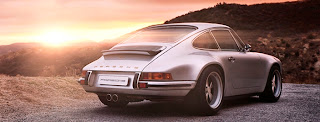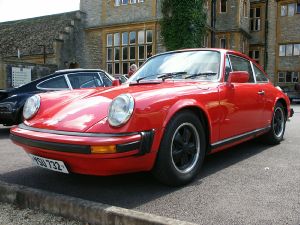Summer 1959, at a dark bar
one night in Stuttgart...
-----------------------------------------------------------
Erwin Komenda: Wow, that's a fantastic design, Butzi! 911, you say? Where does the engine go?'Butzi' Ferdinand Porsche: Err...in the very back, actually.
Erwin: The back? But won't that lead to horrible over-steer?
Butzi: We'll sort that out later.
In reality, the resulting design drawn on a cocktail napkin back 1959 was a resounding success.
But as a general rule, front-wheel drive cars under-steer, rear-wheel drive cars over-steer, and the 911 - a rear-wheel drive car with a lump of iron hanging out the back, managed to be completely unpredictable on all fronts.
It was like going out to a bar with an axe-murderer - it was an interesting evening, and at the end you would die.
911 Carrera S 4
There are two things the industrious Germans are very, very good at: Having no sense of humor whatsoever and making outstanding cars.
Over the past 48 years, Porsche has indeed sorted out the problems of an engine hanging out the back.
Over the past 48 years, Porsche has indeed sorted out the problems of an engine hanging out the back.
In fact, the new 911 Carrera has probably the most tuned chassis in the world. Four-wheel-drive has rendered many issues moot, and in a nutshell, the 911 is finally living up to its mystique.
But we aren't here to talk about that....
No...I'm more interested in where it all started.
From 1963 to 1975, the Porsche 911 was not only an icon, but also was raced and rallied more than any other sports car - and for good reason.
In the early 60s, the McDonnell Douglas F-4 Phantom II was the yardstick that all other air-superiority fighters were measured against.
The same exact thing could be said of the 911, it was the measuring stick put up against everything else on the market....although it was originally designed to be just a more comfortable version of the 356.
I like the fact that just two years before penning the 911, Ferdinand 'Butzi' Porsche had been dismissed by the Walford School of Design for being 'untalented'.
With probably the ultimate 'I told you so' in the history of the world, Butzi put to paper what would be the most recognizable car mankind has ever known.
The first 911's were powered by a flat-six producing 128 horsepower. This would rise over the next few years to 158 bph, and in 1967 the Targa and its stainless-steel cage was introduced.
1976 Targa
The Targa, which would prove to be very popular, was Porsche's answer to anticipated American roll-over laws...instigated by the General Motors Corvair and its tendency to maim people. You can see British-Leyland's answer to these laws in an earlier feature here.
Soon after, the 911's tracking problems were rectified by increasing the width of the car by nearly an inch in 1969, curing a lot of the iffy handling. The 911 handily won races in Sebring, Targa Florio, and Daytona.
The 911 was finally coming into its own.
The 1973-4 911 Carrera RS models are very important collector items. RS stands for Race Sport, and Carrera was derived from the famous Mexican Panamericana races of the 50s.
The duck-tail spoiler, K-Jetronic Bosche fuel injection (replacing mechanical injection) and an enlarged engine producing 210 horsepower were all introduced.
In 1974 something else happened as well. The look of the 911 changed forever. The conformal impact bumper was integrated into the design, and was done so well that it was kept all the way into the late 80s.
In 1975, Porsche got it right again with the 911 Turbo, known as the 930 in America.
This is the 911 you recognize, the look that says it all. Speed, power, handling. The early Turbos were non-intercooled, but it didn't matter. The new turbo-charged 3.0 liter produced 300 horsepower and was heart-stoppingly quick.
A design so good, so perfect, that German engineers decided not to mess with perfection. Which is good for us car lovers.
I have absolutely nothing against the later Porsche 911's, but honestly, the most interesting models have been covered.
The early 911 Turbos are a joy to drive, and I spent many a fine day in one - although they are somewhat cramped for my 6' 3" frame.
From 1990 onward, however, Porsche 911's - for me, at least - become somewhat bland.
I like the early years, particularly 1974 to 1979, and they are still extremely exciting cars to own, even today.
I hesitate, though, to call the 911 a supercar. A strong, sturdy workhorse that changed the world of motoring? That's for certain. But the 911 is too good at what it does to be a supercar.
Supercars are finicky, hard to see out of and difficult to drive.
The 911 is none of those things. It is finely engineered, a little on the heavy side, and very safe. Supercar and safe aren't usually used in the same sentence.
You can buy a 35-year-old Porsche 911 right now for about 15,000 dollars and drive it year round in any type of weather with no problem at all.
Try that in a Lamborghini Miura.





.jpg)


.jpg)


No comments:
Post a Comment